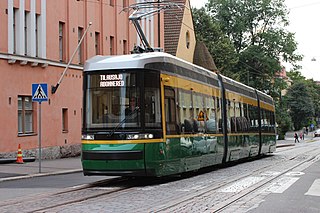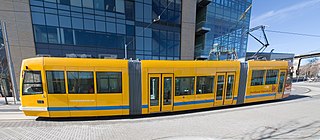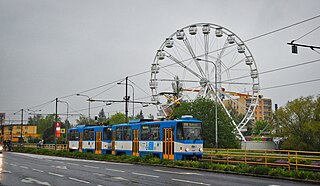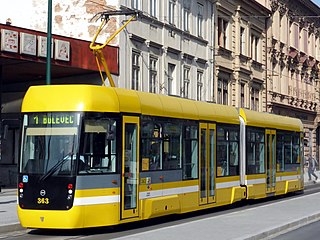History


Formed in 2001, the company was originally a joint venture of Inekon Group and the Ostrava Public Transport Agency (Dopravní Podnik Ostrava, or DPO), and was named DPO Inekon. [2] The name was changed to Inekon Trams in 2005, after Inekon Group purchased the shares of DPO and became sole owner, but DPO's Ostrava facilities continue to be used for most production and assembly. [3]
In the early 1990s Inekon Group tried to gain control of ČKD, which was one of the largest engineering companies in the country at the time, and which had produced almost 20,000 trams, including 14,000 Tatra T3. While the effort to acquire the company failed, some of ČKD's employees were dissatisfied with the new owners and decided to come over to Inekon. Thus, Inekon Group acquired engineers from one of the world's largest producer of trams. [4]
From 1996 [5] until 2001/2, parent company Inekon Group had participated in a joint venture with Škoda Transportation Systems, known as Škoda-Inekon, for the construction of trams. [6] Most of the mechanical design work was undertaken by Inekon Group subsidiary Kolejová Doprava (in Prague), while the production was carried out by Škoda (in Plzeň), and the electrical propulsion equipment was made by Škoda and the Austrian company Elin EBG Traction. [7] Marketing was also handled by Inekon Group. [5] The Škoda-Inekon partnership built the Astra model, of which the unidirectional version, model 03T, was supplied to several Czech cities and the bi-directional version, model 10T, was supplied to two U.S. cities (Portland and Tacoma).
The partnership collapsed in 2001, and strong disagreements resulted in both companies filing lawsuits against the other. [8] Škoda continued producing some of the same models on its own, and retaining the same model designations (such as 03T) as had originally been adopted under Škoda-Inekon, but with Inekon no longer involved. [9] Inekon formed a new joint venture with DPO for production, [10] using DPO's workshops at Martinov, [11] [12] but the design and development of new trams continued to be carried out by Kolejová Doprava, which remains a subsidiary of Inekon Group. [13] For this reason, Inekon's 01-Trio is nearly identical to the Škoda 03T in most respects, while the same is the case for the Inekon 12-Trio and Škoda 10T, respectively. One transport operator, the Portland Streetcar, has a fleet that includes seven Škoda-Inekon 10T cars (built in 2001–2), three Inekon 12-Trio cars and one newer 10T built by United Streetcar under licence from Škoda, and all eleven have identical overall dimensions, configuration, and other technical specifications, and use mostly the same parts. Škoda and Inekon Group settled their differences in 2006, and even forged a new alliance specifically for the purpose of winning a large contract for new trams for Toronto, [8] but that contract was awarded to a different manufacturer, and since then the two companies have continued to work separately.

The first tramcar completed by DPO-Inekon was Ostrava tram system's car 1251, a Trio delivered in 2002. [10] [11] Renamed Inekon Trams in 2005, the company developed additional tramcar designs and expanded into other types of work, in particular overhaul and modernization of older trams [14] and reconstruction and upgrading of tracks. [15] The tram system in Izhevsk, Russia, awarded Inekon a 1 million-euro contract for track repair in 2006, [16] and the city of Ufa also contracted with Inekon for tramway upgrading. [17] Trams have been modernized for Sofia, Bulgaria, [18] [19] and other cities.
In 2007, the Portland Streetcar and Seattle Streetcar systems both took delivery of three Inekon 12-Trio cars each, all six built and assembled in the Czech Republic.
In 2011, Inekon won a tender for 6 new tramcars for the Seattle Streetcar system's "First Hill" line. The Czech company partnered with Seattle-based Pacifica Marine, a transport vehicles refurbisher, in order to meet the requirement of 60% of U.S. content, which is needed for the project to be eligible for Federal funding. While the manufacturing of the major parts would still take place in the Czech Republic, assembly, painting and testing was to be carried by the American company for this order. At the time, Inekon and Pacifica planned to bid also for streetcar projects in other U.S. cities, with plans to eventually start building streetcars completely in the U.S., similar to United Streetcar's partnership with Škoda. [20] [21] [22] [23] The Seattle order was later expanded by one car, to seven cars, but after production fell behind schedule, the plans for U.S. assembly were scaled back. Three of the new Seattle cars were assembled in the Czech Republic, and only four by Pacifica Marine in Seattle. The three Inekon trams purchased by Seattle earlier, in 2007, were model 12-Trio, whereas the new cars purchased by Seattle in 2013–15 are a variant called 121-Trio, which is capable of operating on batteries only (without power from overhead wires) part of the time. [24]
Due to low figures of production, Inekon's manufacture of trams has been loss-making and the parent company has to subsidise the tram division from its other activities, such as constructing large cement mills (currently planned or under construction in Egypt, Morocco, Syria and Vietnam), modernisations of trains as well as train corridors and construction of large sewage plants (in Ireland, the Netherlands, Italy, Latvia, etc.). Nevertheless, Inekon maintains capacities for production of trams as well as for their development, aiming to sell them especially in the American, Russian and Chinese tramway markets. [25]
















